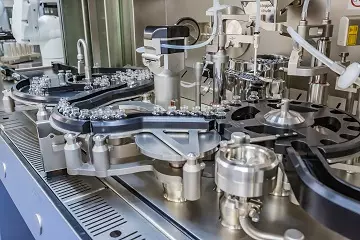Understanding the Requirements for Particle Monitoring in Pharmaceutical Cleanrooms begins with a grasp of the current regulations. The current international standards for defining contamination levels in cleanrooms are EU GMP Annex 1 and the International Standard ISO 14644-1.
These cleanroom standards apply to a variety of cleanrooms, whether they are for industrial use, sensitive semiconductor manufacturing, or aseptic production.

Image Credit: Particle Measuring Systems
Pharmaceutical cleanrooms are classified based on the required air particle concentration to meet the cleanliness criteria for the specific manufacturing process. Following ISO 14644-1 standards, a lower classification number indicates a lower particle concentration.
Originally, cleanrooms were classified by the number of particles per cubic foot at 0.5 microns (µm) because it was a reliable size for repeated testing. The cleanroom class determination involves statistically valid measurements and is divided into three phases:
- As-Built: A completed room with all services connected and functional, but no production equipment or personnel are present.
- At Rest: All services are connected, and equipment is operating, but no personnel is present.
- Operational: All equipment is installed, functioning as specified, and a defined number of personnel are present, working according to established procedures.
The particle count test is performed by counting particles at defined grid locations within the cleanroom, with the number of measurements varying based on the cleanroom class and statistical requirements mentioned in the standards.
The standards also stipulate that the data should allow for the determination of the classification level with a 95% confidence level. It is recommended to use a particle counter with 0.5 µm sensitivity for pharmaceutical manufacturing ISO class definition.
Pharmaceutical cleanrooms typically operate at Class 5 (most aseptic areas), Class 7 (surrounding areas), or Class 8 (support areas). The minimum number of samples needed for a specific area is detailed in ISO 14644-1:2015 Revisions Summary.
Once a cleanroom's classification aligns with a standard using a particle counter, it determines the production activities permissible in that cleanroom. To learn more, download the complete paper to explore topics like:
- Monitoring particulates in critical and supporting areas
- Portable counters and FMS systems
- Manifold systems
- Special considerations for sterilizing tunnels and lyophilization
About Particle Measuring Systems
Particle Measuring Systems has 35 years experience designing, manufacturing, and servicing microcontamination monitoring instrumentation and software used for detecting particles in air, liquid, and gas stream as well as molecular contamination monitoring.
Specific applications include cleanroom monitoring, parenteral sampling, filter and in-line testing in deionized water and process chemicals, and point-of-use monitoring of inert gases and in-situ particle monitoring. Specialty monitoring includes parts cleanliness testing with a highly automated solution.
Particle measuring systems
Whether you want to protect product or meet industry requirements, such as ISO 14644, USP 797, or GMP, Particle Measuring Systems has a large variety of particle counters and molecular monitors to meet your needs. With 35 years experience, we have the proven reliability to support your application.
Particle counters
Protect your product with our reliable particle counters. We have airborne, portable, and liquid particle counters for a wide variety of applications including DI water, chemicals, and cleanroom monitoring. Compare particle counters or learn how to monitor your cleanroom or product by reading our papers.
Molecular contamination monitors
Molecular contamination creates costly problems to high value products, production processes, and equipment surfaces. We have solutions for both Airborne Molecular contamination (AMC) and Surface Molecular contamination (SMC). With parts-per-trillion limits of detection, real-time sampling, NIST traceable calibrations, and various data analysis packages, you can monitor in confidence.
Gas detectors
If you need gas detectors for process control or continuous emissions monitoring, we can help. Get real-time, reliable results with our ammonia, hydrogen fluoride, and chlorine detectors for worker protections, CEMs, and pollution monitoring.
Sponsored Content Policy: News-Medical.net publishes articles and related content that may be derived from sources where we have existing commercial relationships, provided such content adds value to the core editorial ethos of News-Medical.Net which is to educate and inform site visitors interested in medical research, science, medical devices and treatments.